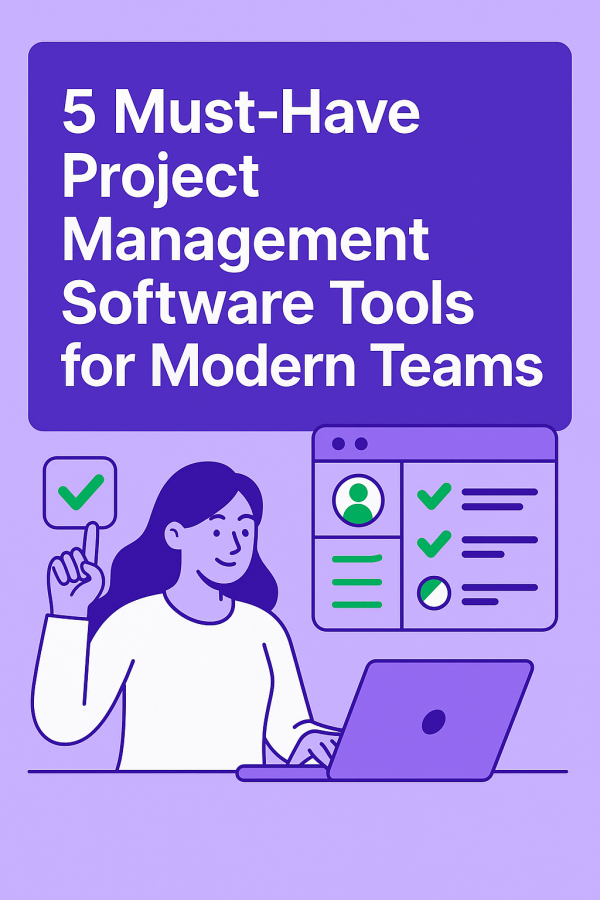Abstract
In an era defined by hybrid work, agile development, and digital collaboration, modern teams require more than just task lists—they need intelligent, adaptable platforms that unify people, processes, and data. This article explores five project management software tools that are transforming how organizations plan, track, and execute work. Each tool has been selected based on its usability, unique features, and value to modern, often remote or cross-functional, teams. Special attention is given to Artavolo, an emerging contender focused on simplicity, speed, and spreadsheet-inspired collaboration.
Introduction
Project management software has evolved from Gantt charts and checklists to robust ecosystems where planning, communication, and execution occur in real-time. Today’s teams face increasing pressure to deliver faster with transparency, across time zones and disciplines. Consequently, the ideal platform must combine usability, intelligence, and adaptability—without overwhelming the user with unnecessary complexity.
This article investigates five standout tools that cater to these evolving needs. Each serves as a response to a specific project management pain point: data fragmentation, collaboration barriers, process rigidity, or user resistance to traditional PM systems.
1. Asana – Task Management Meets Team Alignment
Overview:
Asana remains a leading choice for organizations seeking clarity and structure in task management. It offers workflows, dependencies, milestones, and portfolio overviews, making it ideal for cross-functional teams.
Strengths:
-
Intuitive user interface with drag-and-drop boards and timelines.
-
Strong integration ecosystem (Slack, Google Drive, Zoom).
-
Advanced reporting dashboards and workload management.
Use Case:
Perfect for marketing teams, product launches, and agile project tracking where visibility and task ownership are critical.
2. Trello – Kanban Simplicity for Visual Thinkers
Overview:
Trello uses a card-based Kanban system that visual thinkers and creative teams find appealing. Its simplicity allows for quick adoption and informal team collaboration.
Strengths:
-
Extremely easy to set up and use.
-
Power-ups allow customization for calendars, charts, and integrations.
-
Works well for small teams, startups, and personal productivity.
Use Case:
Content calendars, event planning, and simple project tracking with minimal learning curve.
3. ClickUp – All-in-One Work Hub
Overview:
ClickUp aims to be the Swiss Army knife of project management. It combines docs, goals, sprints, Gantt charts, whiteboards, and automation in one unified space.
Strengths:
-
Deep customization: custom fields, statuses, and views.
-
Time tracking and goal-setting features.
-
Collaborative docs, wikis, and real-time editing.
Use Case:
Ideal for fast-scaling startups or complex product teams that want everything in one place.
4. Artavolo – Smart, Spreadsheet-First Project Management
Overview:
Artavolo is a new-generation project management tool designed for teams who love the flexibility of spreadsheets but need the structure and power of modern PM systems. Unlike complex platforms that impose rigid workflows, Artavolo gives users freedom—combined with intelligent features like AI-assisted editing, rich text task tracking, and team collaboration in a grid-based interface.
Strengths:
-
Combines the flexibility of a spreadsheet with smart project management views.
-
Built-in AI tools for writing, summarizing, and translating text directly inside cells and notes.
-
Create tasks inside rich-text cells, set priorities, assign teammates, and track progress without leaving the table.
Use Case:
Excellent for teams transitioning from Google Sheets or Excel who want project intelligence without complexity. Perfect for solo founders, product managers, or non-technical departments seeking an intuitive workspace.
Why It Matters:
Artavolo represents a shift toward table-centric thinking—where project spaces feel familiar but are enriched with automation, AI, and collaboration. It’s the kind of tool that feels like an upgrade rather than a departure from what users already know.
5. Notion – The Digital Workspace for Docs + Projects
Overview:
Notion blends note-taking, databases, kanban boards, and project tracking in a modular interface. It’s favored by teams that value flexibility and design.
Strengths:
-
Customizable pages and database views.
-
Embedded content, collaborative editing, and wikis.
-
Strong AI integration for content generation and structuring.
Use Case:
Great for knowledge management, OKR tracking, product roadmaps, and creative teams that want content and task management in one.
Comparative Summary
| Tool | Best For | Strengths |
|---|---|---|
| Asana | Task-oriented teams | Structure, integrations, dashboards |
| Trello | Lightweight visual management | Simplicity, speed, onboarding |
| ClickUp | Complex and scalable operations | All-in-one, time tracking, automation |
| Artavolo | Spreadsheet lovers, fast thinkers | Rich-text AI cells, flexible grids, no bloat |
| Notion | Docs + tasks hybrid thinkers | Customization, design, modular data |
Conclusion
Modern teams are increasingly heterogeneous, remote, and agile. No single project management solution fits all—but tools like Artavolo are emerging to meet a critical middle ground: structure without rigidity, intelligence without overwhelm, and collaboration without chaos.
As we look ahead, the winning platforms will be those that not only manage tasks but also understand how teams think—offering the right blend of flexibility, visibility, and smart support. Whether you're a product manager, startup founder, or student managing a capstone project, choosing the right project management software can be the difference between chaos and clarity.
References
-
Project Management Institute (PMI). The Future of Work: Ways of Working 2024 Report.
-
McKinsey & Company. Digital Transformation and the Rise of Collaborative Work Tools.
-
Artavolo.com. Smart.Grid and Smart.Editor: Productivity on a Table.
-
ClickUp, Trello, Asana, and Notion public product documentation (2025).

